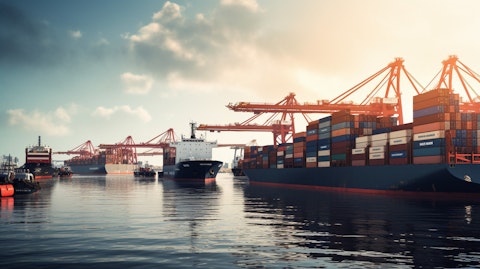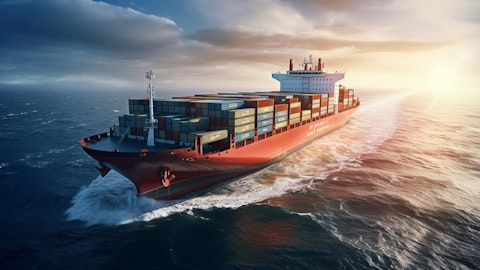Matson, Inc. (NYSE:MATX) Q3 2025 Earnings Call Transcript November 4, 2025
Matson, Inc. beats earnings expectations. Reported EPS is $4.24, expectations were $3.25.
Operator: Thank you for standing by, and welcome to the Matson Third Quarter 2025 Financial Results Conference Call. [Operator Instructions] As a reminder, today’s program is being recorded. And now I’d like to introduce your host for today’s program, Justin Schoenberg, Director of Investor Relations and Corporate Development at Matson. Please go ahead.
Justin Schoenberg: Thank you. Joining me on the call today are Matt Cox, Chairman and Chief Executive Officer; and Joel Wine, Executive Vice President and Chief Financial Officer. Slides from this presentation are available for download at our website, www.matson.com, under the Investors tab. Before we begin, I would like to remind you that, during the course of this call, we will make forward-looking statements within the meaning of the federal securities laws regarding expectations, predictions, projections or future events. We believe that our expectations and assumptions are reasonable. We caution you to consider the risk factors that could cause actual results to differ materially from those in the forward-looking statements in the press release, the presentation slides and this conference call.
These risk factors are described in our press release and presentation and are more fully detailed under the caption Risk Factors on Pages 24 to 35 of our Form 10-Q filed on May 6, 2025, and in our subsequent filings with the SEC. Please also note that the date of this conference call is November 4, 2025, and any forward-looking statements that we make today are based on assumptions as of this date. We undertake no obligation to update these forward-looking statements. I will now turn the call over to Matt.
Matthew Cox: Thanks, Justin, and thanks to those on the call. I’ll start on Slide 3. In the third quarter, our business segments performed well in a difficult environment marked by continued uncertainty and volatility arising from tariffs and global trade. In Ocean Transportation, operating income was lower year-over-year, primarily due to lower year-over-year freight rates and container volume in our China service. In our domestic tradelanes, we saw higher year-over-year volume in Hawaii and Alaska, and lower year-over-year volume in Guam. In Logistics, our operating income was lower year-over-year, primarily due to lower contributions from freight forwarding, transportation brokerage and supply chain management. For the fourth quarter 2025, we expect consolidated operating income to be approximately 30% lower year-over-year.
We’re also optimistic and expect a more stable trading environment for our customers starting in the fourth quarter as a result of the reduction in uncertainty regarding tariffs, port entry fees, global trade and other geopolitical factors due to the trade and economic deal between the U.S. and China announced on October 30. Joel will go into more detail on our updated forecast and outlook later in the presentation. I will now go through the third quarter performance of our trade lanes, SSAT and Logistics. So please turn to the next slide. Container volume in our Hawaii service increased 0.3% in the third quarter year-over-year. For the full year 2025, we expect volume to be comparable to the level achieved in 2024, reflecting modest economic growth in Hawaii and stable market share.
Please turn to Slide 5. According to UHERO’s September Economic report, the Hawaii economy is softening as slowing tourism and high inflation and interest rates weigh against stronger construction activity. Construction is a bright spot in the Hawaii economy, supported by public sector projects and the Maui rebuilding effort. Hawaii tourism softened considerably over the summer as tourist arrivals and spending declined year-over-year in part due to tariff uncertainties impacting international tourism. Moving to our China service on Slide 6. Container volume in the third quarter of 2025 decreased 12.8% year-over-year, primarily due to the difficult environment marked by continued uncertainty and volatility arising from tariffs and global trade.
Freight rates in the quarter were lower year-over-year. Please turn to Slide 7. The Transpacific tradelane in the third quarter experienced a muted peak season compared to the elevated demand levels last year, due to businesses advancing cargo in the late second quarter and early third quarter ahead of U.S. tariff deadlines, which led to slower third quarter demand for our expedited services. The muted demand we experienced in the third quarter persisted through October as customers continue to navigate tariff uncertainty. As such, for the fourth quarter 2025, we expect lower year-over-year freight rates and volume in our China service as we expect many of our China service customers to be cautious on inventory levels and work through previously purchased inventory.
However, we expect a more stable trading environment for our customers in the fourth quarter of 2025 as a result of the reduction in uncertainty regarding tariffs, port entry fees, global trade and other geopolitical factors due to the trade and economic deal between the U.S. and China announced on October 30. Please turn to Slide 8. When port entry fee collection commenced in the U.S. and China on October 14, we did not let these fees impact our China service. We advised our customers that our CLX and MAX services from China would not change and that port entry fees would not be passed on to them. At that time, based on our initial assessment of our anticipated fleet schedule, vessel charters and expected dry dockings, we expected to pay approximately $20 million in port entry fees in the fourth quarter 2025 and approximately $80 million annually in port entry fees in 2026 and 2027.
Then on October 30, the U.S. and China reached a trade and economic deal. The deal includes a 1-year suspension of port entry fees and a cumulative reduction by 10% for tariffs on Chinese imports to curb fentanyl flows for 1 year, each starting on November 10. We expect the USTR and the China Ministry of Transport to publish specific instructions regarding port entry fees shortly. This was a welcome development, and we are optimistic that this is a positive step towards a longer-lasting agreement between the 2 countries. Quarter-to-date, we have paid $6.4 million in port entry fees. Again, we have not passed these port entry fees on to our customers. Our philosophy in the tradelane is to charge rates based on the value we provide with our expedited services given the underlying supply and demand conditions.
In our nearly 20 years of operating our China service, we have not passed on surcharges or temporary fees to our customers, and we did not and do not intend to do so with these port entry fees. I want to underscore that we are business as usual with the CLX and MAX services operating without interruption. We remain committed to the Transpacific tradelane and are highly confident in our positioning with the 2 fastest and most reliable Transpacific services and we will continue providing our CLX and MAX customers with world-class service. Moving to the next slide. In Guam, Matson’s container volume in the third quarter of 2025 decreased 4.2% year-over-year due to lower general demand. In the near term, we expect Guam’s economy to moderate, reflecting a challenging tourism environment.

As such, for the full year 2025, we expect volume to be modestly lower than the level achieved last year. Please turn to Slide 10. In Alaska, Matson’s container volume for the third quarter of 2025 increased 4.1% year-over-year. The increase was primarily due to one additional northbound sailing compared to the year ago period and higher AAX volume. In the near term, we expect continued economic growth in Alaska, supported by a low unemployment rate, job growth and continued in oil and gas exploration and production activity. As such, for the full year 2025, we expect container volume to be modestly higher than the level achieved last year. Please turn to Slide 11. In the third quarter, our SSAT terminal joint venture contributed $9.3 million, representing a year-over-year increase of $2.4 million.
The increase was primarily due to higher lift revenue. For full year 2025, we expect the contribution from SSAT to be higher than the $17.4 million achieved last year without taking into account the $18.4 million impairment charge recorded by SSAT during the fourth quarter of 2024. Turning now to Logistics on Slide 12. Operating income in the third quarter came in at $13.6 million or $1.8 million lower than the result in the year ago period. The decrease was primarily due to lower contributions from freight forwarding, transportation brokerage and supply chain management. In the fourth quarter of 2025, we expect Logistics operating income to be modestly lower than the level achieved last year. And with that, I will now turn the call over to my partner, Joel, for a review of our financial performance.
Joel?
Joel M. Wine: Okay. Thanks, Matt. Please turn to Slide 13 for a review of our third quarter results. For the third quarter, consolidated operating income decreased $81.3 million year-over-year to $161 million with lower contributions from Ocean Transportation and Logistics of $79.5 million and $1.8 million, respectively. The decrease in Ocean Transportation operating income in the third quarter was primarily due to lower freight rates and volume in China. As Matt noted, the decrease in logistics operating income was primarily due to lower contributions from freight forwarding, transportation brokerage and supply chain management. We had interest income of $7.6 million in the quarter compared to $10.4 million in the same period last year.
Interest expense in the quarter was unchanged year-over-year. Net income decreased 32.3% year-over-year to $134.7 million and diluted earnings per share decreased 28% year-over-year to $4.24 per share. Lastly, diluted weighted average shares outstanding decreased 5.9% year-over-year. Please turn to Slide 14. We continue to generate strong cash flows. For the trailing 12 months, we generated cash flow from operations of $544.9 million. We returned capital in the form of dividends and share repurchases of $302.5 million, and we had maintenance CapEx of $186.6 million. Our cash flow from operations exceeded the aggregate spend on maintenance CapEx, dividends and share repurchases by $55.8 million. Please turn to Slide 15 for a summary of our share repurchase program and balance sheet.
During the third quarter, we repurchased approximately 0.6 million shares for a total cost of $66.4 million, including taxes. Year-to-date, we repurchased approximately 2 million shares for a total cost of $229.3 million, including taxes. Since we initiated our share repurchase program in August of 2021 through September of this year, we have repurchased approximately 13.1 million shares or 30.2% of our stock for a total cost of approximately $1.2 billion. As we have said before, we are committed to returning excess capital to shareholders and plan to continue to do so in the absence of any large organic or inorganic growth investment opportunities. Turning to our debt levels. Our total debt at the end of the third quarter was $370.9 million, a reduction of $10.1 million from the end of the second quarter.
Please turn to Slide 16, where I will walk through our outlook. Based on the outlook trends Matt mentioned earlier, we expect Ocean Transportation operating income to be lower than the $137.4 million achieved in the fourth quarter of 2024. For Logistics, we expect operating income in the fourth quarter of 2025 to be modestly lower than the level achieved last year. In total, we expect consolidated operating income in the fourth quarter to be approximately 30% lower than the prior year. In addition, we expect the following for the full year 2025. Depreciation and amortization to approximate $196 million, inclusive of $28 million for dry dock amortization. Interest income to be approximately $32 million and interest expense to be approximately $7 million, other income to be approximately $9 million, an effective tax rate of approximately 22.0% and dry-docking payments of approximately $45 million.
Lastly, I’d like to discuss our CapEx projections for the full year 2025. Compared to what we previously provided on our second quarter earnings call, our expectation for maintenance and other capital expenditures this year has increased to approximately $130 million due to some CapEx now expected to occur before the end of 2025 versus previously expected to occur in early 2026. Overall, we are confident our annual maintenance CapEx will remain in the $100 million to $120 million range going forward. Our estimate for expected new vessel construction milestone payments in 2025 is now approximately $248 million. This is lower than our prior estimate as a milestone payment has been pushed back to the first half of 2026. Please note that, the total cost of our new vessel program remains the same at approximately $1 billion.
Please turn to Slide 17. I wanted to spend a moment on our current CCF funding of the new vessel build program. As of September 30, the $628 million in cash deposits and treasury securities in our capital construction fund covers approximately 92% of the remaining milestone payment obligations, which excludes future interest income or accretion earned on cash deposits and treasury securities. Assuming the interest income rate on our CCF money market funds remains at our current rate of 4%, we expect only approximately $28 million of additional CCF cash deposits to be required for the final milestone payments in late fourth quarter 2027. In addition to the current CCF balance, we also had $93 million in cash and cash equivalents as of September 30.
These 2 balances combined exceed our remaining milestone payments, so we are in a great funding position on the new build program. This year, in the fourth quarter, we expect to make approximately $101 million in milestone payments from the CCF, of which we already made approximately $36 million in milestone payments in October. Lastly, the targeted build schedule also remains unchanged. We recently received an update from Hanwha Philly Shipyard, and there has been no change to the schedule we previously communicated. We continue to expect our 3 vessels to be delivered in the first quarter of 2027, the third quarter of 2027 and the second quarter of 2028. With that, I’ll turn the call back over to Matt.
Matthew Cox: Okay. Thanks, Joel. In closing, as we continue to navigate through this period of market uncertainty and volatility, Matson remains well positioned and diversified across its tradelanes and in logistics. We will continue to focus on what we can control. Across all our business lines, we continue to work closely with our customers to manage their transportation needs in an evolving marketplace. We are also steadfast in maintaining the highest levels of service reliability and delivery delivering superior customer service. Decades of experience have proven to us that Matson’s future success and growth is a function of how well we deliver for our customers during unsettled times. We believe that the trade and economic deal announced on October 30 is an important positive step forward towards a more stable economic trading environment. And with that, I will turn the call back to the operator and ask for your questions. Thanks.
Q&A Session
Follow Matson Inc. (NYSE:MATX)
Follow Matson Inc. (NYSE:MATX)
Receive real-time insider trading and news alerts
Operator: Certainly, and our first question for today comes from the line of Jacob Lacks from Wolfe Research.
Jacob Lacks: So pricing has clearly held in well, just given everything going on, on the Transpacific lane right now. We’ve seen a lot of pressure on more traditional spot rates over the past few months. Do you view the current pricing levels as sustainable? Or do you think there could be some further pressure from here just with weakness in the more traditional ocean market?
Matthew Cox: Yes. Thanks for the question. So, I think we did make a conscious choice to hold our prices as we saw the SCFI and the spot rate fall pretty dramatically in the last quarter or so. And that was really based on a belief in our sense that we would see a little bit less expedited volumes for reasons that we talked about earlier. And we’re very pleased with our pricing. As we’ve said many times, we are — we have a different pricing algorithm coming out of the pandemic, and we really are trading at multiples, some of the highest spreads over the market rates that we’ve ever seen in absolute dollars. So, I guess the way I would describe that now, where we typically go is that we do typically see a period of market adjustments as we get through traditional peak and once all the merchandise is delivered, and that usually happens sometime in October for a few months until we get ramping up for Lunar New Year.
So, I would say our absolute freight rates are likely to come down, but in a very orderly way and very consistent with our previous seasonal patterns. So really nothing surprising or no major significant changes to the way we’ve thought about the market.
Jacob Lacks: That’s helpful. And then it’s — I think you touched on this a little bit, but the utilization headwinds in the quarter, is that just your actions on pricing? Do you think there’s sourcing changes out of China that are impacting it? It would be great to get your perspective.
Matthew Cox: Yes. My perspective on this was there was certainly additional capacity in the Transpacific market, but our utilization little bit lower levels was really borne out of an insight that because of the dramatic premium in our pricing relative to the market pricing that we couldn’t lower our prices enough to create additional demand that which needed to move in an expedited fashion was going to pay the Matson premium for getting its cargo to the market in a very reliable and fast way. So, our sense was that ours had a little bit more to do with the front-loading of inventory. And if you’re front-loading hundreds of thousands of SKUs, you’re likely to have a little bit less need for expedited product, if you’re moving it all into a warehouse. And it was really more that function that, I think drove our utilization rather than supply and demand in the broader market.
Jacob Lacks: Makes sense. And maybe just one quick clarification. Are the $6.4 million in port fees, are those included in the operating profit down 30% in 4Q? Or are those excluded?
Matthew Cox: Yes, they are. They’re included.
Operator: And our next question comes from the line of Omar Nokta from Jefferies.
Omar Nokta: I actually have a few questions that pretty much follow up on everything that Jacob was asking you guys were talking about. And maybe just on this first one, I know it’s not a lot, but in terms of that $6.4 million in port fees, is there a mechanism for you to get that refunded back or some kind of rebate? Is there any kind of discussion on that front?
Matthew Cox: So, Omar, we mentioned in our prepared comments just a moment ago that we were awaiting final — the USTR and the China Ministry of Transport final regulations that we expect those to be issued shortly in the next week or 2. And we will be able to determine whether that was an element or not.
Omar Nokta: Okay. So just making sure, the $6.4 million that was incurred accounting-wise? Or was it actually like a cash outflow?
Matthew Cox: It was a cash outflow. Those are due upon arrival or prior to departure each week. So those are paid each week.
Omar Nokta: Okay. Okay. And then obviously, clearly, Matson, you’re performing very strongly despite all the headwinds we’ve been seeing, especially kind of in light of the muted peak season you had talked about, and sort of been expecting. Just in terms of what we’ve been seeing here recently in the spot market, obviously, your earnings aren’t going up and down or swinging as dramatically as say, the spot market does. But I wanted to get a sense of what you’re sort of seeing develop today. Spot rates on the Transpacific fell to lows back in early October, but they’ve had a nice sort of sharp rebound off the bottom. Just from your vantage point, are you seeing that kind of in your business? Is it increased activity that’s driving some of these gains? Or is it — are these index rates maybe moving up for some other reason?
Matthew Cox: Yes. I mean, I can — let me answer it directly first and then indirectly, if I can. The actions that are happening on pricing now are really having 0 impact on Matson’s pricing. We really are pricing on a totally different threshold, which is customer that — customers who have cargo that need to move fast to meet whether it’s a late production or whether it’s unforecasted demand that — where they need to replenish cargo. So, we’re quite disconnected from those market mechanisms. But more broadly, I see this as an effort by the international ocean carriers to get freight rates up from a level that I believe they see are really not profit making and doing their best to try to get rates up to a more stabilized level, especially as we get past the peak season for cargo in the markets. And whether they’re those will be achieved will be subject to other ocean carriers handicapping that. But it really is having no impact on us.
Omar Nokta: Okay. I appreciate that color. And maybe just a final one. Joel, we had spoken, I think, back in maybe early September and sort of discussing the load factors and how — I think you mentioned this in your remarks earlier, perhaps you were running in the 90s in terms of load factor earlier in the year, you were willing to take that down into the 70s and maintain rate. How has that evolved since? Are you still kind of operating in that 70s region?
Joel M. Wine: Yes. So, I mean, it’s different for the CLX and the MAX. And the key observation, Omar, was that for the last 20 years, we’ve been basically full for 20 years. So, this period going back to April, when the first big round of tariff escalation occurred where we were — our volumes were down significantly, that was the first time we experienced that. So then as we moved into May and June and then the traditional peak season, there was a number of dynamics happening in the market that led us to maintain our pricing, as Matt’s talked about, but we didn’t necessarily get all the way back to full. So even now to today, since April, we haven’t been full at all during that entire period of time. So, it’s really been a function of maintaining our rates and then working with our customers as they have continued to build inventory and ship, but not — but — and then based upon that, the utilization factors have leveled out where they were.
And you just — you can kind of see and estimate what that is based upon the volumes we just reported for the quarter relative to the year prior when we were full of the whole year. So that’s kind of the dynamic that’s played out and continue to play out here as we post the news on October 30.
Operator: [Operator Instructions] Our next question comes from the line of Reed Seay from Stephens Inc.
Reed Seay: I wanted to ask about your customer conversations at this point. It’s been a pretty crazy year for Transpacific ocean cargo. Are they potentially getting a little weary of sourcing from China? Or at this point, do they seem pretty steadfast and sticking it out through these trade discussions and all the deals?
Matthew Cox: Yes. This is Matt. Let me take a crack at that. I think what we’re seeing is an expansion of trends over these last few years. So, it was a China-centric a few years ago, manufacturing strategy. They were the world’s factory floor. And then I think as a result of some political turmoil, we saw many of our customers evolve into a China Plus One strategy, which took all of the eggs out of one basket given the volatility and what had happened through the pandemic and other things. So, I think over time, you saw our customers, large retailers diversify their sourcing. I think you see with the — more recently, with some of the discussions and issues between the U.S. and Chinese governments, we see a continuing long-term trend of our customers looking to identify multiple sourcing for their products.
I think that’s a long-term trend that’s going to continue. I think it’s also true, however, that China will continue to be a very important source of manufacturing into the foreseeable future. So, I think both are true. We’re continuing to see customers look to diversify whether it’s in Southeast Asia or other Mexico or other locations. We’re also seeing the continued strengths of the ability to source out of China. So, I think both are going on at the same time.
Reed Seay: Got it. And then kind of on a similar vein, you’ve talked about the catchment basin in the past couple of quarters. Can you talk about maybe where you’re seeing a lot of this volume from the CLX and MAX maybe as a share of — from Vietnam or from other sources just as we see it in the third quarter?
Matthew Cox: Yes, sure. I can touch on that as well. So, I think we — you can use 20%, which is what we reported last quarter as a good indicator of the amount of cargo that is on the CLX and MAX services that come from other than China origin. And those are North and South Vietnam, where we started in 2023 and then earlier this year, separate services from North Vietnam and South Vietnam. We also see cargo moving from Cambodia over the border to catch up with our Ho Chi Minh service in the South. We’re also seeing cargo come out of Thailand, of Malaysia, of the Philippines. But I would say, as of now, the largest chunks of our cargo are really coming out of Vietnam at this point. But we do expect, for example, Thailand and other origins to continue to grow as we transition into 2026 and beyond.
Reed Seay: Got it. And lastly, if you could just talk about maybe the pricing within your domestic lanes, Alaska and Hawaii now are a little more stable. I guess, China is more stable now, too. But can you just talk about how those are progressing and whether or not you’ve had some gains there?
Matthew Cox: Yes. I mean on our domestic trades, our approach has been and continues to be — we tend to do annual rate increases that mirror increases in our underlying costs, whether that be for labor or other inputs. We have a floating — as you may know, we have a fuel surcharge that adjust based on our actual cost of fuel in each of the tradelanes and based on the fuel that we’re consuming in those markets. And so, our approach there is really around recovering increases in costs, whether those were port terminal fees or pass-through. So, I would say our — we’ve seen a relatively steady pricing environment. We’ve been relatively successful in continuing to see real year-over-year increases in line with our costs. And those are really the highlights of our pricing dynamics that have been and continue to be those that drive our current performance.
Operator: This does conclude the question-and-answer session of today’s program. I’d like to hand the program back to Matt Cox for any further remarks.
Matthew Cox: Okay. Well, thanks, everybody. We appreciate your dialing in today. And again, to repeat myself, I think we really are encouraged and optimistic by this October 30 deal date, 30th date between U.S. and China. And I think it will really reduce some of the planning uncertainty for our customers who’ve been trying to live through this period of relative instability. So, we’re encouraged by that, and I will look forward to catching up with everyone on our year-end call. Thanks.
Operator: Thank you, ladies and gentlemen, for your participation in today’s conference. This does conclude the program. You may now disconnect. Good day.
Follow Matson Inc. (NYSE:MATX)
Follow Matson Inc. (NYSE:MATX)
Receive real-time insider trading and news alerts




